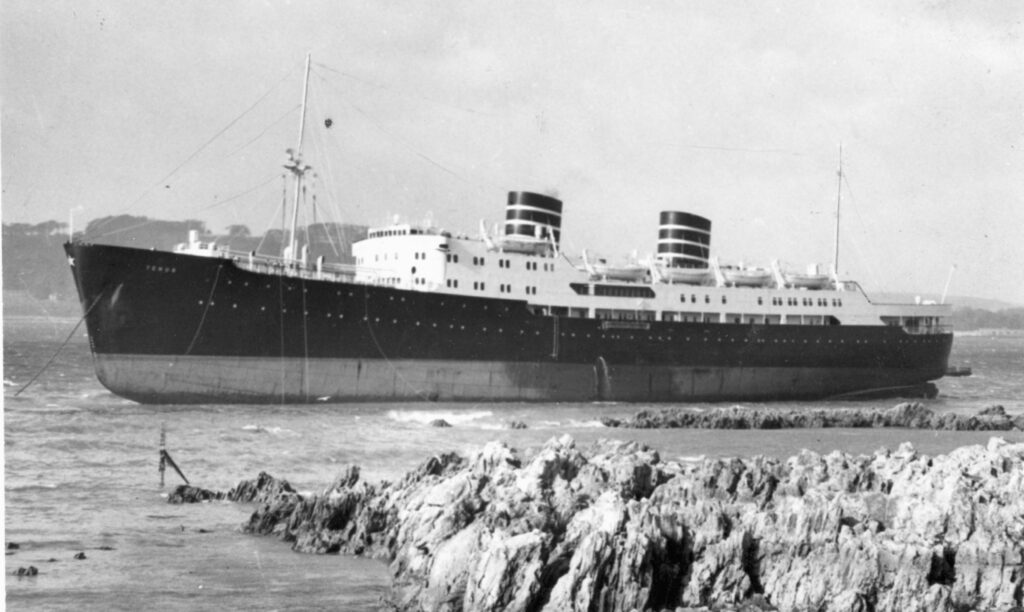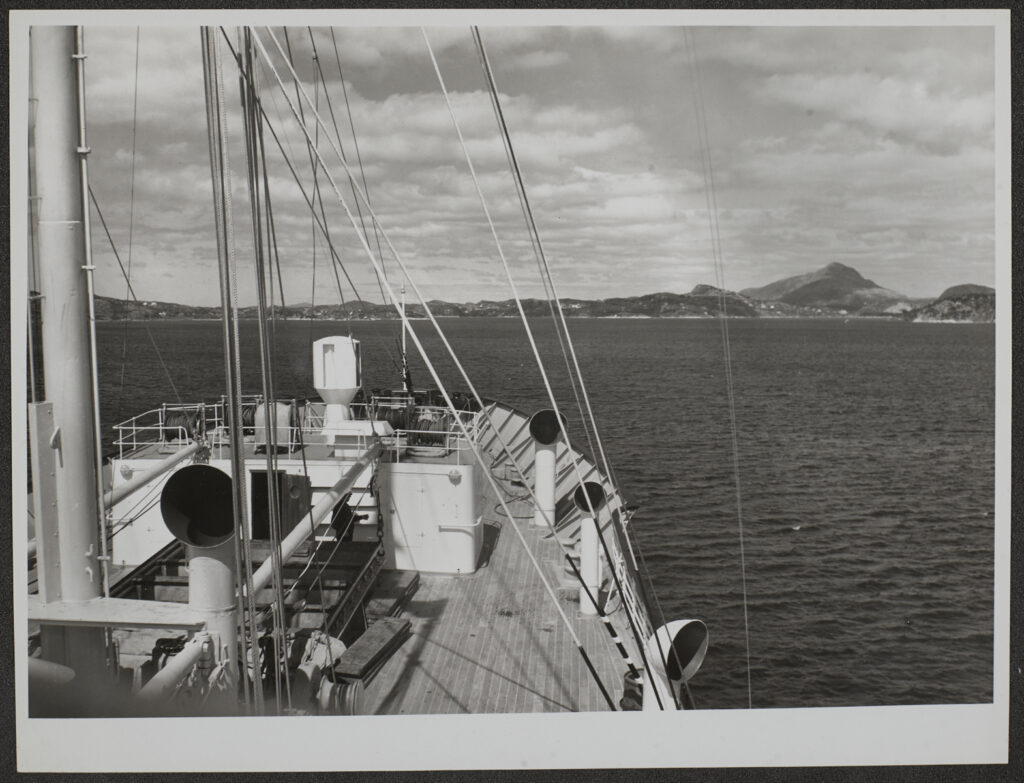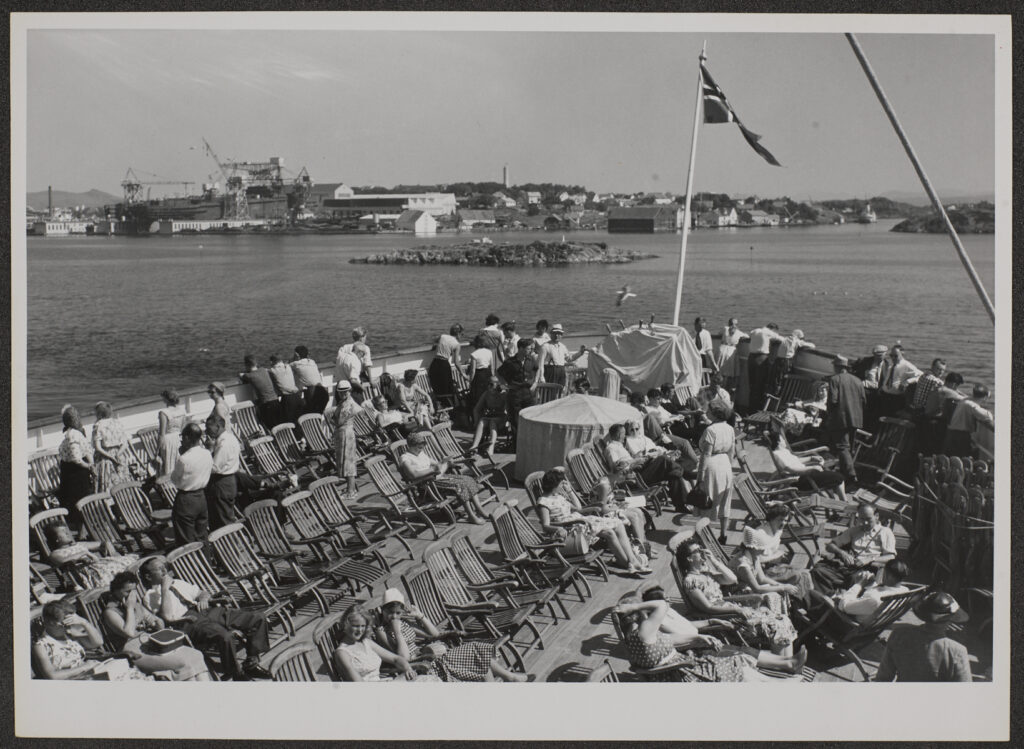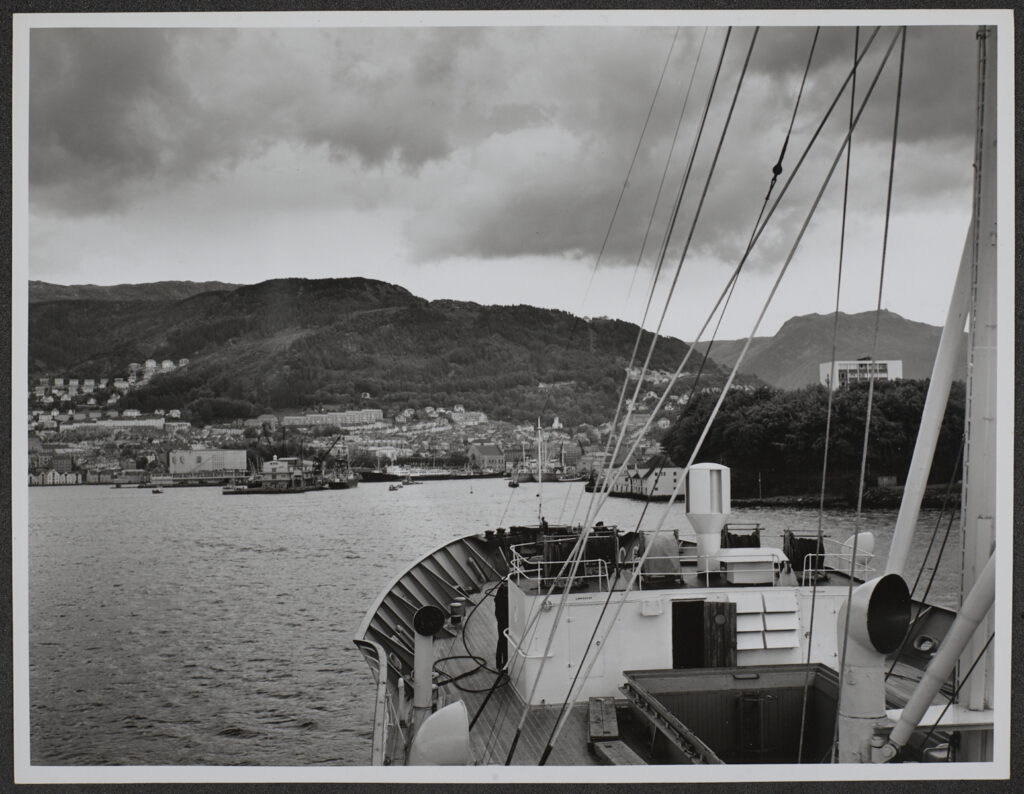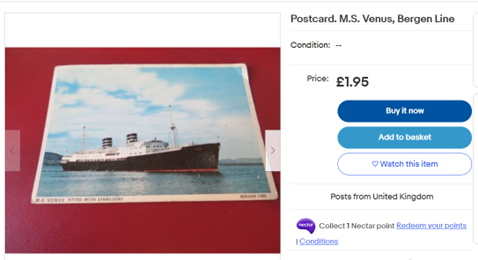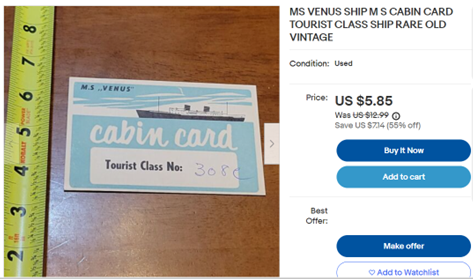Audio Version
Read by Christopher Williams
Text Version
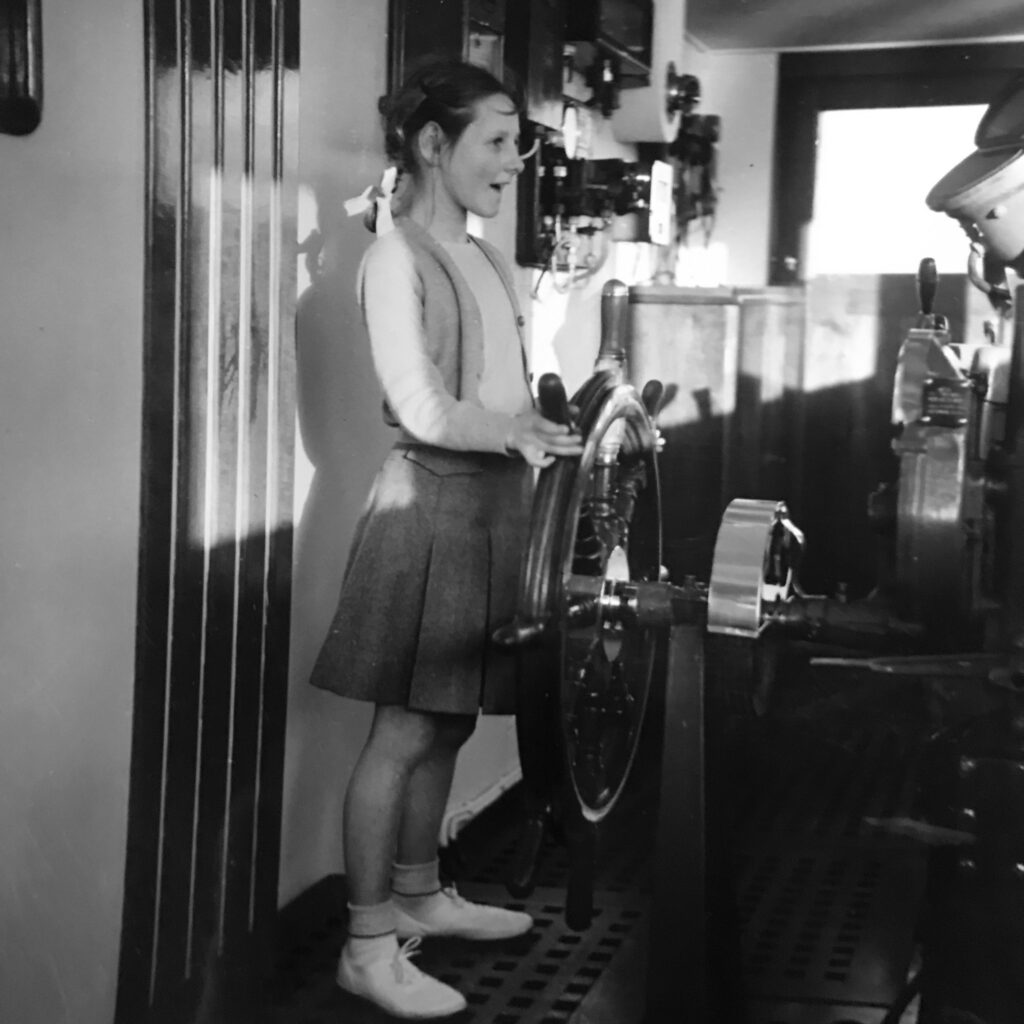 On Board Venus: Motor Vessel: Captain.
On Board Venus: Motor Vessel: Captain.
Image by Anthony Kersting. KER_PNT_N01525, The Courtauld, CC-BY-NC
My fellow Digitisation Volunteer Richard True has described in two blog posts how he set about trying to identify the girl ‘Mary’ at the wheel of a passenger ship called ‘Venus’.
Mary features in a photograph taken by Anthony Kersting on a voyage from Southampton to Madeira in March 1953.
The links to his blog posts are below – and he does track her down!
Search for Kersting’s Mary Continues
My curiosity was piqued by Richard’s search: what is the story of the other ‘she’ in the photographs, namely, the ship herself?
What a story it turned out to be:
- a source of Norwegian national pride when she entered service in 1931, dubbed the ‘Queen of the North Sea’ and featuring royalty on her passenger lists;
- requisitioned in WW2 by Nazi Germany and used to train U-boats in the Baltic;
- sunk at Hamburg by allied bombers;
- re-floated at the war’s end – Venus rises from the waves!
- repaired and returned to peacetime sailing;
- running aground in a storm in Plymouth Sound and again rising from the waves!
- in her most glorious hours, rescuing the crew of a stricken vessel in horrendous conditions in the North Sea, to international acclaim and as commemorated in oils by the eminent maritime artist Frank Mason.
This is her story…
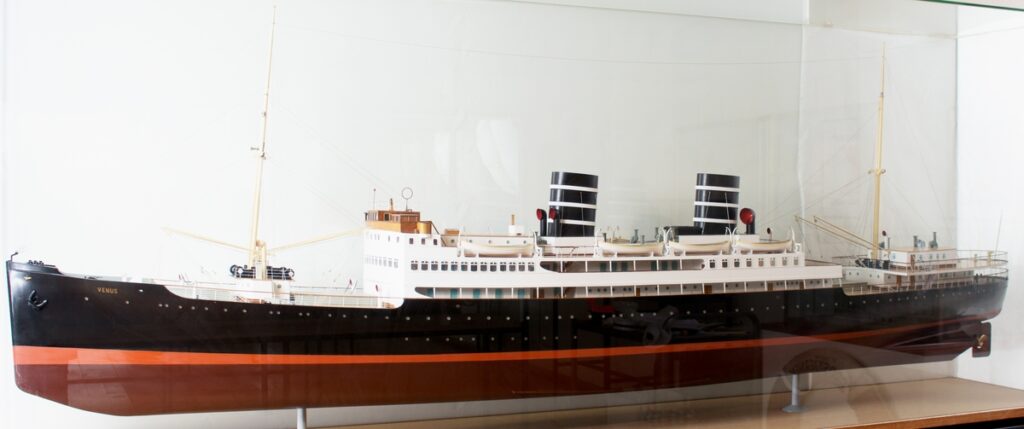 Display model of MS Venus as originally configured, 1930s. Photo: Bergens Sjøfartsmuseum
Display model of MS Venus as originally configured, 1930s. Photo: Bergens Sjøfartsmuseum
Built at Helsingør (Elsinor) in Denmark, MS Venus was owned by the Bergen Steamship Company (Norwegian: Bergenske Dampskibsselskab or BDS) – the company’s funnels were painted black with three widely spaced narrow white bands. She had a gross tonnage of 5407, a length of 398 ft and a beam of 54 ft; she was a twin-screw vessel powered by 2x Burmeister & Wain four-cycle, 10-cylinder diesels delivering a total of some 9,500 bhp, giving her a speed of 19.5 knots. The ship originally had cabins for 278 passengers. She cost NOK 5.2 million when delivered in April 1931 and was the most expensive ship BDS had owned to date.
On 30 April 1931, Venus went to Oslo to be presented to King Haakon VII and representatives of the Norwegian government and the Storting. The king raised a toast on behalf of the fatherland and believed that such a beautiful ship as Venus must be at the service of the whole country. A few days later, the Danish king stated after seeing the ship that there was only one fault with her; that she did not belong to a Danish shipping company.
On 6 May 1931, she took her maiden voyage from Bergen to Newcastle. In the years leading up to WW2, she maintained a summer service along with another BDS ship of four round trips per week, with departures from Bergen at 11.00 on Mondays, Wednesdays, Thursdays and Saturdays, and from the purpose-built Tyne Commission Quay, North Shields, Newcastle at 19.30 on Mondays, Tuesdays, Thursdays and Saturdays. Queen Maud of Norway was a frequent passenger until her death in 1938 and other notable travellers included the Thai royal family in 1936.
It was on one of these inter-war journeys that Venus had undoubtedly her finest moment. Late at night on 19 January 1937, Venus was en route to Newcastle in a storm when an SOS was heard from the cargo vessel Trym, which was en route from Kirkenes to Middlesbrough. Venus went to assist and remained standing by Trym, with the winds increasing to hurricane force. First attempts at rescue were thwarted until early in the morning of the 21 January, Venus launched a lifeboat with 9 volunteers under the leadership of 2nd Mate Rolf Andreassen. With extra-ordinary bravery, Ordinary Seaman Perry Opsahl on the Trym jumped into the wild seas and swam to take a line to the lifeboat, allowing six of Trym‘s crew to be taken off and brought back to Venus.
With conditions worsening and the Trym at risk of foundering, Captain Dreyer of the Venus manoeuvred close to Trym so that a line could be fired from the bow across to the Trym so that those still on board could be hauled over the wild seas to safety. All were saved. The success of this rescue made headlines across Europe. British newspapers referred to it as the most heroic rescue operation of the century and portrayed Captain Dreyer as a wise, calm and masterful Viking.
Venus received a great reception on return to Bergen – probably 25,000 people showed up. Opsal from Trym and those of the crew of Venus who had participated directly in the rescue operation were awarded the ‘medal for noble deeds’. First mate Brynjulf Bjarnir and nine crew members were awarded the King’s Medal of Merit in gold. Opsal also received a gift of NOK 10,000 from the city of Oslo.
As well as these Norwegian awards, the committee of Lloyd’s in London commemorated the event with a bronze plaque and awarded medals for saving life at sea to Captain Dreyer and those who manned the boat from Venus.
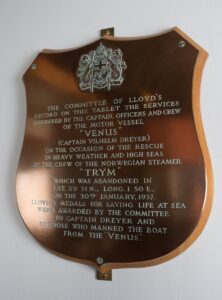 Lloyd’s Commemorative Plaque. Photo: Bergens Sjøfartsmuseum
Lloyd’s Commemorative Plaque. Photo: Bergens Sjøfartsmuseum
 Trym and Venus, painting by FH Mason, oil on canvas, 60cmx100cm – detail. Photo: Bergens Sjøfartsmuseum
Trym and Venus, painting by FH Mason, oil on canvas, 60cmx100cm – detail. Photo: Bergens Sjøfartsmuseum
The rescue of the last crew members was depicted in a painting by Frank Henry Mason RBA, RI, RSMA (1875-1965), an English artist best known for his maritime, shipping, coastal and harbour paintings, and as a creator of art deco travel and railway posters.
He had served in the Great War as a Lieutenant in the Royal Naval Volunteer Reserve – undoubtedly giving him a further insight into depicting maritime events.

His painting Trym and Venus now hangs in Bergens Sjøfartsmuseum (Bergen Maritime Museum). Look closely and you can see a crewman from Trym being hauled across to Venus, suspended from the line running between the two ships.
Darker times lay ahead for Venus, however. Following the outbreak of World War 2 and the occupation of Norway by German forces, Venus was requisitioned by the Kriegsmarine and sailed to the Baltic Sea under the German flag, to be rebuilt at Neptunwerft in Rostock, where the interior was removed. The ship was then used as a training target by the 26th U-boat Flotilla, which trained newly commissioned U-boats in the firing of torpedoes. In 1945, as the Soviets advanced deeper into Eastern Europe, the flotilla relocated westwards. Finally, on 20 March 1945, Venus was bombed and sunk by Allied aircraft in Walterhofer Hafen near Hamburg. One bomb hit the aft hatch and another hit next to the ship, causing her to sink – though the water was so shallow that parts of her structure remained above the surface.
But her story did not end there.
In June 1945, it was decided that it would be possible, though expensive, to salvage her. This work took until early 1948 to complete; she was repaired and refitted in Helsingør, Aarhus and Copenhagen in Denmark and Landskrona in Sweden.
A cargo hold on the ship was scrapped and passenger accommodation increased and a garage fitted out. After the conversion, the ship could take 143 passengers in 1st class, 257 in 2nd class and an additional 60 in a cheaper class aimed at groups of young travellers – totalling 460 passengers, against 278 passengers before the war. The bow, deckhouse and bridge were also modernised. The restoration cost around NOK 16 million.
On 4 May 1948, she arrived back in Oslo to be displayed, where it was agreed that it was still right to call her the “Queen of the North Sea”. King Olaf of Norway said it had been a pleasure to have the MS Venus again “in her new, beautiful guise”. The next day, she sailed into Bergen, after visiting Stavanger and Haugesund. Six thousand people turned up on the quay to welcome her. The first trip to England after her restoration took place on 8 May 1948, sailing first to London then on to Newcastle before the return trip to Bergen.
During the summer seasons, MS Venus continued to sail the North Sea route from Bergen to Newcastle. Every winter season from December to April from 1948 until the mid 1960s, MS Venus offered ten-day cruises from Southampton or Plymouth in Great Britain to Madeira and Tenerife in the Canary Islands, which also took advantage of the cargo opportunity provided by the import of fruit and vegetables to the UK. It was one of these cruises in the spring of 1953 that carried Anthony Kersting and his camera – and when he pictured ‘Mary’ on the bridge at the ship’s wheel.
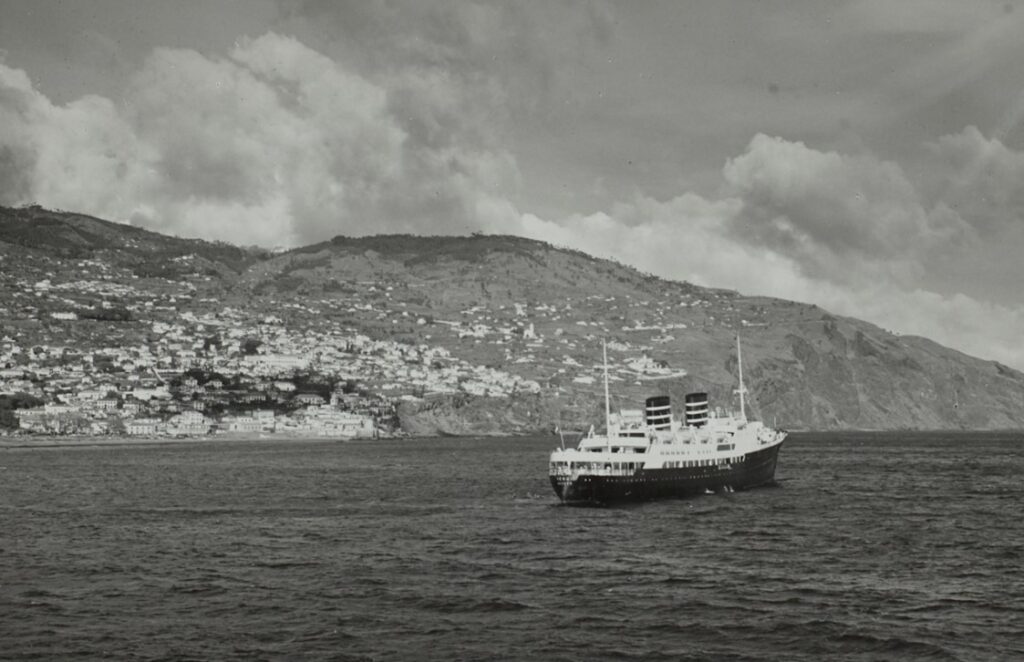
Portugal, Madeira, Funchal, Harbour: Motor Vessel Venus, 25 March 1953.
Detail of image by Anthony Kersting. KER_PNT_N01577, The Courtauld, CC-BY-NC
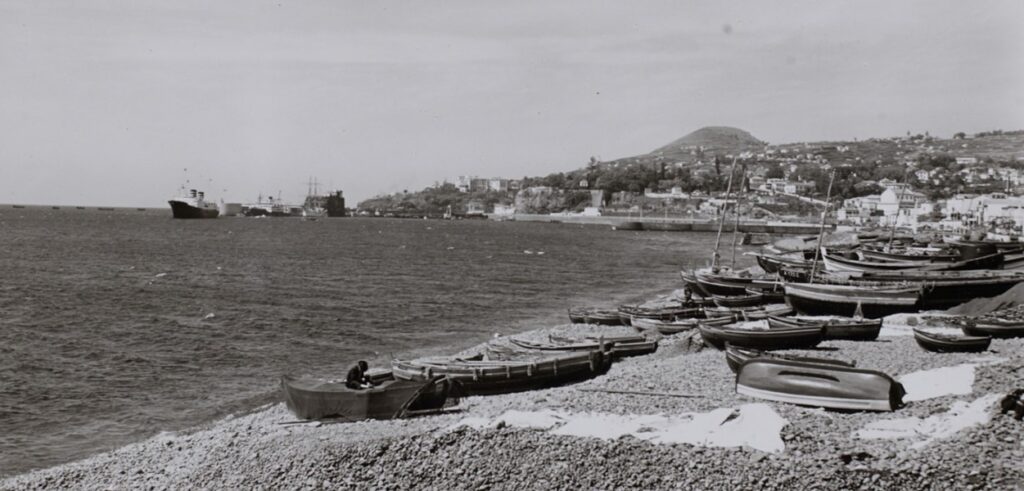 Portugal, Madeira, Funchal, Shore, 25 March 1953.
Portugal, Madeira, Funchal, Shore, 25 March 1953.
Detail of image by Anthony Kersting. KER_PNT_N01575, The Courtauld, CC-BY-NC
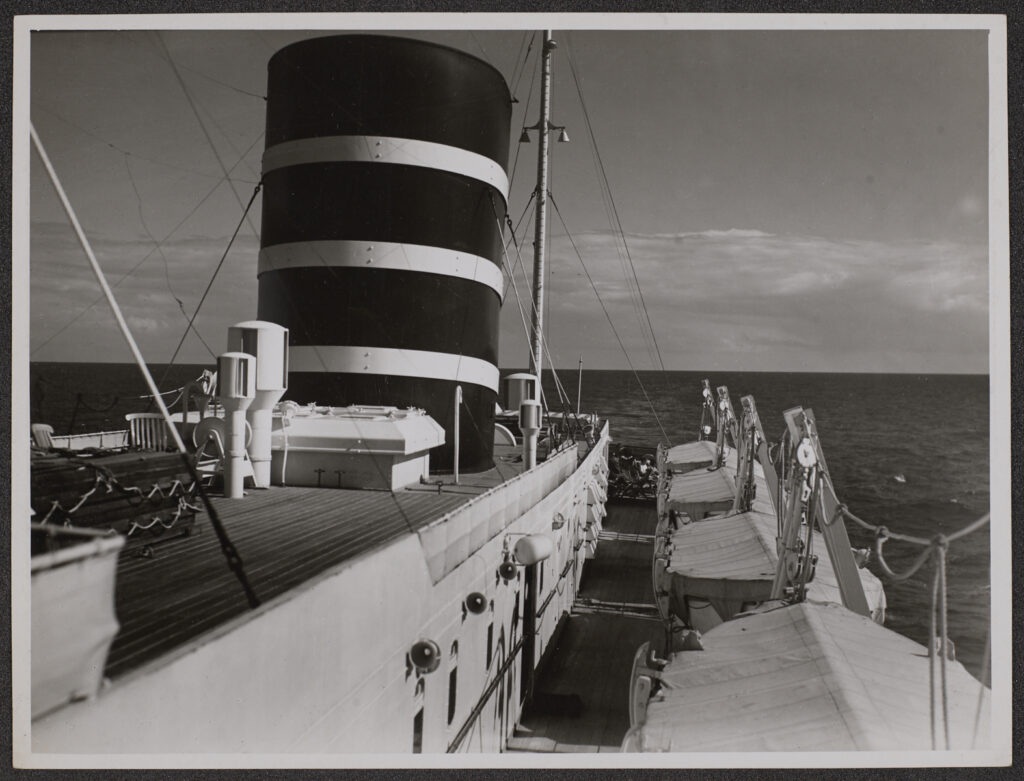 MV Venus: On Board, 23 Mar 1953.
MV Venus: On Board, 23 Mar 1953.
Image by Anthony Kersting. KER_PNT_T000003, The Courtauld, CC-BY-NC
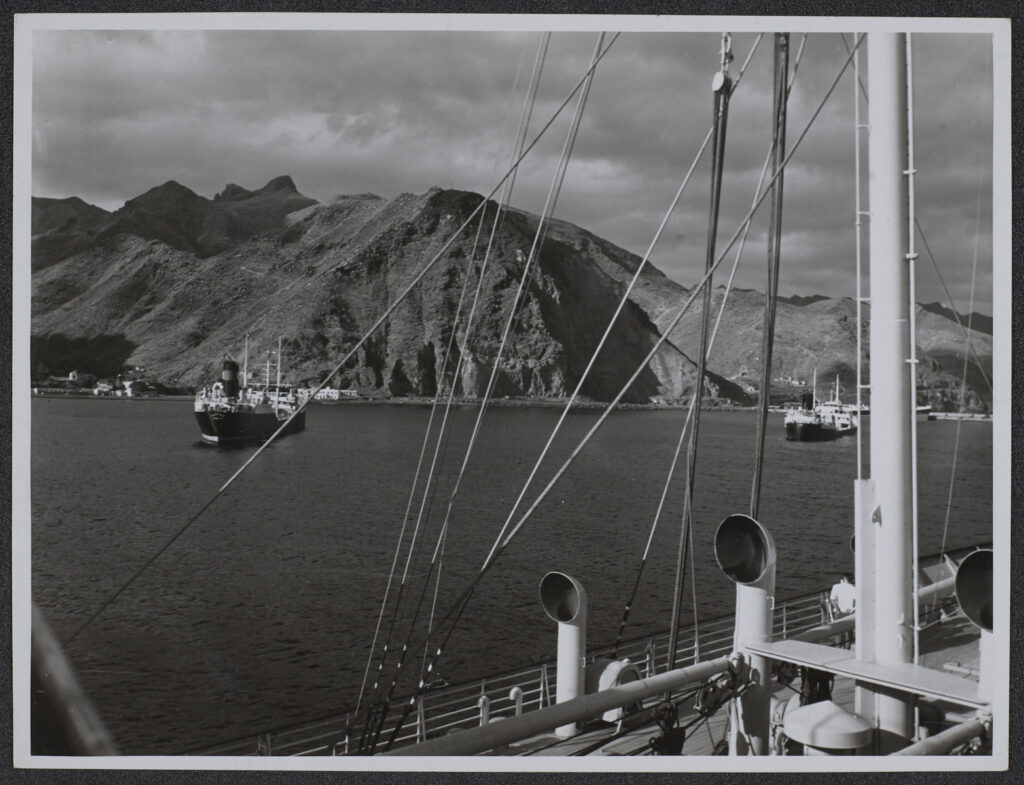 Spain, Canary Islands, Tenerife. 6 April 1953.
Spain, Canary Islands, Tenerife. 6 April 1953.
Image by Anthony Kersting. KER_PNT_N01570, The Courtauld, CC-BY-NC
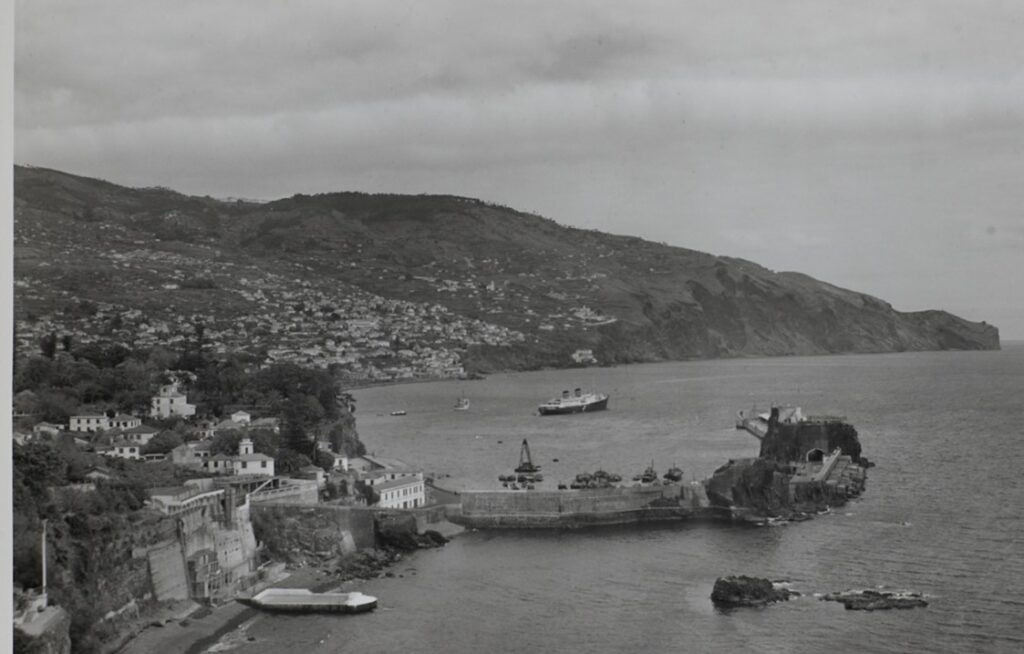 Portugal, Madeira, Funchal, From Reid’s Hotel, 26 March 1953.
Portugal, Madeira, Funchal, From Reid’s Hotel, 26 March 1953.
Detail from image by Anthony Kersting. KER_PNT_H07489, The Courtauld, CC-BY-NC
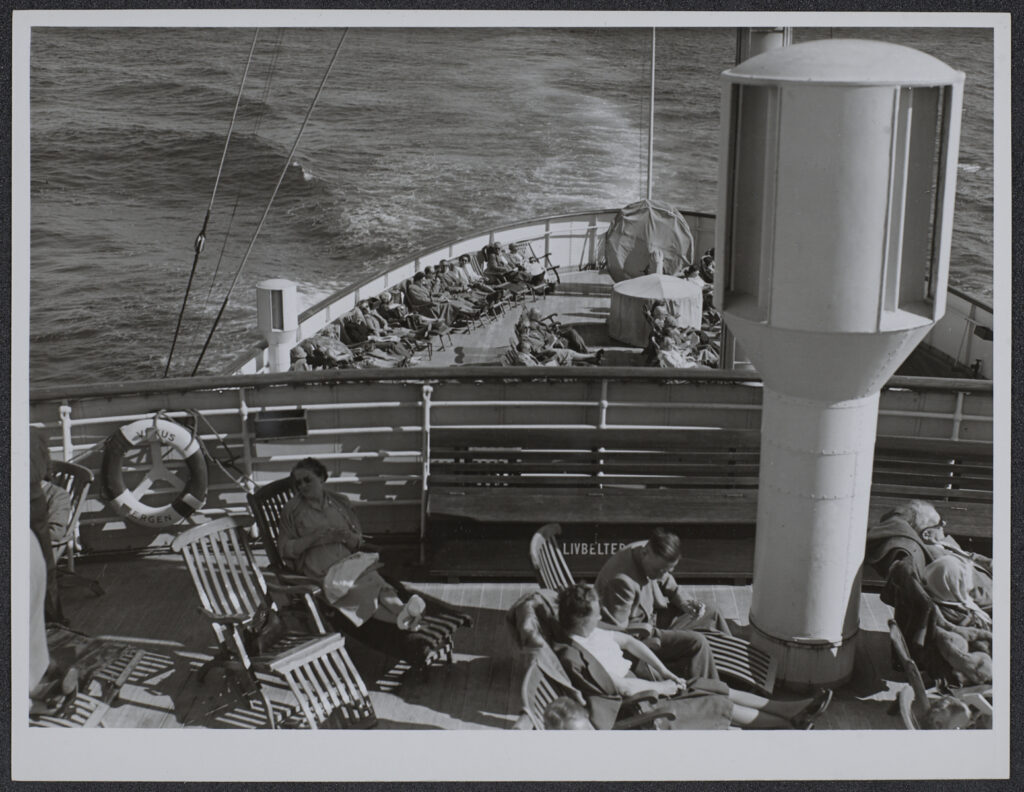 MV Venus: On Board, 23 March 1953.
MV Venus: On Board, 23 March 1953.
Image by Anthony Kersting. KER_PNT_T000002, The Courtauld, CC-BY-NC
Not all voyages were smooth sailing. Most conspicuously, on 23 March 1955, Venus dragged her anchors in a storm in Plymouth Sound and ran aground on the Mountbatten Reefs on the eastern shore of the Sound. Three tugboats arrived in the morning to try to pull the ship free, but without success. All on board, apart from essential crew, were put ashore.
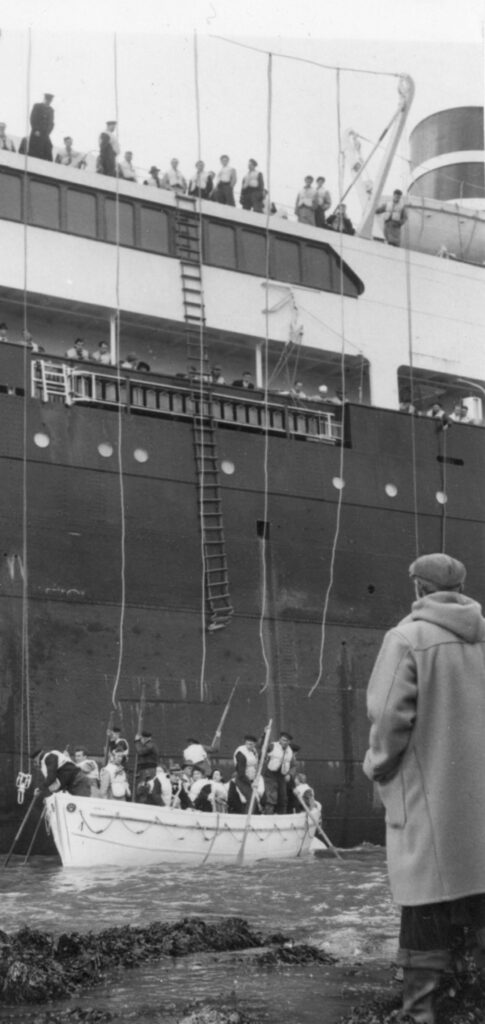
Venus aground in Plymouth Sound, March 1955.
Photographer(s) unknown. Source: M/S Museet for Søfart [Maritime Museum of Denmark] – Berlingske Tidende
Major damage was visible at the bottom of the hull and there was water seeping into some of the cabins. Compressed air was used to keep the water out. Finally, on 26 March when there was a spring tide, the salvage crew managed to pull the ship free at the fourth attempt. She was towed into Plymouth and examined by divers to get a full overview of the damage: outer plates in the bottom were torn up and a leak was discovered in the tanks forward and amidships.
Some of these events in Plymouth Sound were captured on film in unused British Pathé News footage, which can be seen in this YouTube clip.
She was eventually towed to Amsterdam for full repairs to be carried out; she arrived back in her home port Bergen on 31 May to resume her sailing schedule – and to give Kersting further opportunities to sail on her on his photo expeditions.
Norway, Venus in Bergen Fjord, June 1958.
Image by Anthony Kersting. KER_PNT_N02197, The Courtauld, CC-BY-NC
Norway, On Venus, June 1958.
Image by Anthony Kersting. KER_PNT_N02229, The Courtauld, CC-BY-NC
Norway, Vestland, Bergen, Bergen Fjord: M/S Venus, 14 July 1962.
Image by Anthony Kersting. KER_PNT_G02178, The Courtauld, CC-BY-NC
In early 1965 the ship made two cruises to the Mediterranean and the Greek Islands, before starting on a new direct route from Stavanger to Newcastle, but still making some calls to Bergen. In March 1966, Venus again set out on a cruise to the Mediterranean, this time as far east as Haifa in Israel.
In contrast to this time cruising in Mediterranean sun, financial clouds were however gathering over MS Venus. Four cruises planned for the autumn of 1968 from Southampton to the Canary Islands were cancelled because of poor ticket sales. BDS put the ship up for sale – her fate was sealed when she was bought for scrapping by Shipbreaking Industries Ltd. based at Faslane on the Lower Clyde. On 5 October she arrived in Bergen for the last time. Valuable objects and artworks were removed and on 17 October 1968 she sailed on her final journey from Bergen to the Clyde and her destruction.
This is how the Norwegian newspaper Bergens Tidende described her departure on its front page:
“The 36-year-old North Sea Queen set out from the quay at Laksevåg and headed across the Puddefjord towards Nordnes and made an elegant turn outside the Skoltegrunnskaien, where it has docked for all these years. With a series of deep blasts from the whistle it sent a final salute into the town and instantly there was a response from a number of boats from the harbour… bidding the proud ship farewell. And then the course was set west, for the last time Venus rounded Kvarven and disappeared out of sight from the city as hundreds of proud schooners have done before her.”
*
Epilogue – Did she ‘Leave not a wrack behind’? – Not quite.
You can still bid for MS Venus memorabilia on e-Bay!
Items for sale on e-Bay, 4 April 2023 – exactly 70 years after Kersting’s voyage to Madeira and the Canaries on MS Venus
And of course, you can trawl the Courtauld Digital Archive for images of the ship and the places she visited with Kersting and his camera on board.
Christopher Williams, Digitisation Volunteer, May 2023
***
Sources:
There is a comprehensive [Norwegian language] history of MS Venus on Wikipedia at:
https://no.wikipedia.org/wiki/MS_%C2%ABVenus%C2%BB
and of the Bergen Steamship Company (Bergenske Dampskibsselskab – BDS) at: https://en.wikipedia.org/wiki/Bergen_Steamship_Company
*
Maritime Museums:
Norway: Bergens Sjøfartsmuseum: https://digitaltmuseum.no/owners/BSJ
Denmark: M/S Museet for Søfart: https://mfs.dk/
*
The grounding in Plymouth Sound is featured in British Pathé News unused footage ‘SS [sic] Venus Runs Aground (1955)’ duration 2m:12s, viewable at:
https://www.youtube.com/watch?v=6zrJXI2skrQ
Eyewitness accounts and images of the grounding and repairs in Plymouth can be found on this forum: https://www.submerged.co.uk/gotaway-venus/
*
The artist Frank Henry Algernon Mason’s life and works are described here:
https://en.wikipedia.org/wiki/Frank_Henry_Mason
and here:
https://www.pannettartgallery.org/havens-and-harbours-the-marine-art-of-frank-henry-mason/

